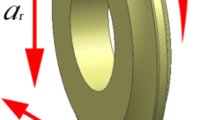Abstract
Generating gear grinding is a hard finishing process mainly used to meet the high requirements for gears in terms of geometry and surface quality. However, due to the high friction generated in the contact zone, high temperatures are achieved, which might cause thermal damages. To avoid the generation of these damages, an analysis of the resulting energy conversion is recommended. The energy conversion is significantly influenced by the interaction between each grain engaging with the material in the contact zone. However, current approaches for energy description do not take into consideration the grinding tool topography due to the random and complex distribution of the grains in terms of position and shape in the contact zone. For the specific case of generating gear grinding the challenge is increased due to the complex contact conditions induced by the process kinematics.
The objective of this work is the investigation of the influence of the grains on the material removal behavior and the implementation of this influence on a generating gear grinding energy model. The research is focused on an empirical investigation of a single-grain trial and on the transferability of the findings first onto an analogy trial with surface grinding process and last onto an analogy of the continuous generating gear grinding process.
The energy was analyzed in terms of normal force during generating gear grinding. An alternative approach for the modelling of the normal force taking into consideration the tool topography for the process of generating gear grinding was developed. According to the results, the alternative approach for the calculation of the normal force presented in this work showed a promising method, even though further optimization is still required. Ultimately, the alternative approach for normal force calculation can be further developed for the thermo-mechanical energy determination for generating gear grinding process.
Zusammenfassung
Das Wälzschleifen ist ein Hartbearbeitungsverfahren, das hauptsächlich zur Erfüllung der hohen Anforderungen an Zahnräder in Bezug auf Geometrie und Oberflächenqualität eingesetzt wird. Durch die hohe Reibung in der Kontaktzone werden jedoch hohe Temperaturen erreicht, die zu thermischen Schädigungen führen können. Um die Entstehung dieser Schädigungen zu vermeiden, wird eine Analyse der resultierenden Energieumwandlung empfohlen. Die Energieumwandlung wird maßgeblich durch die Wechselwirkungen zwischen den einzelnen Körnern beeinflusst, die mit dem Material in der Kontaktzone in Eingriff kommen. Aktuelle Ansätze zur Energiebeschreibung berücksichtigen jedoch aufgrund der zufälligen und komplexen Verteilung der Körner in Bezug auf Position und Form in der Kontaktzone, nicht die Schleifwerkzeugtopographie. Für den speziellen Fall des Verzahnungswälzschleifens erhöht sich die Herausforderung durch die komplexen Kontaktbedingungen, die durch die Prozesskinematik verursacht werden.
Ziel dieser Arbeit ist die Untersuchung des Einflusses der Körner auf das Zerspanungsverhalten und die Umsetzung dieses Einflusses auf ein Energiemodell zum Wälzschleifen. Die Forschung konzentriert sich auf eine empirische Untersuchung eines Einkornprozesses und auf die Übertragbarkeit der Ergebnisse zunächst auf einen Analogieprozess eines Flachschleifprozesses und zuletzt auf eine Analogie des kontinuierlichen Verzahnungswälzschleifprozesses.
Die Energie wurde hinsichtlich der Normalkraft beim Verzahnungswälzschleifen analysiert. Ein alternativer Ansatz zur Modellierung der Normalkraft unter Berücksichtigung der Werkzeugtopographie für den Prozess des Wälzschleifens wurde entwickelt. Nach den Ergebnissen zeigte der in dieser Arbeit vorgestellte alternative Ansatz zur Berechnung der Normalkraft eine vielversprechende Methode, auch wenn noch weitere Optimierungen erforderlich sind. Schließlich kann der alternative Ansatz zur Normalkraftberechnung für die thermo-mechanische Energiebestimmung zur Erzeugung des Verzahnungsschleifprozesses weiterentwickelt werden.





Similar content being viewed by others
References
Malkin S, Guo C (2007) Thermal analysis of grinding. Ann Cirp 56:761–782
Rasim M (2015) Wärmeentstehung im Schleifprozess in Abhängigkeit von der Schleifscheibentopographie. RWTH Aachen, Diss
Klocke F, Wrobel C, Rasim M, Mattfeld P (2016) Approach of characterization of the grinding wheel topography as a contribution to the energy modelling of grinding processes. Procedia CIRP 46:631–635
Tönshoff HK, Peters J, Inasaki I, Paul T (1992) Modelling and Simulation of Grinding Process. CIRP. Annals, vol 41, pp 677–688
Rowe WB (2009) Principles of Modern Grinding Technology. Applied Science Publishers, Oxford
Heinzel C, Sölter J, Jermolajev S, Kolkwitz B, Brinksmeier E (2014) A versatile method to determine thermal limits in grinding. Procedia CIRP 13:131–136
Linke B, Garrestson I, Torner F, Seewig J (2017) Grinding energy modeling based on friction, plowing and shearing. J Manuf Sci Eng 139. https://doi.org/10.1115/1.4037239
Reimann J (2014) Randzonenbeeinflussung beim kontinuierlichen Wälzschleifen von Stirnradverzahnungen. RWTH Aachen, Diss
Werner G (1971) Kinematik und Mechanik des Schleifprozesses. RWTH Aachen, Diss
Teixeira PO, Löpenhaus C, Brecher C, Klocke F (2018) A multi-grain approach for micromechanical contact in grinding. Advances in Production Research—Proceedings of the 8th Congress of the German. Academic Press, Association for Production Technology, pp 271–284
Schriefer H, Thyssen W, Wirz W, Scacchi G, Gretler M (2008) Kontinuierliches Wälzschleifen von Verzahnungen, 1. Auflage, Eigenverlag Reishauer AG, Wallisellen
Acknowledgements
The authors would like to thank the German Research Foundation (DFG) for the support of the presented research within the project: EXC2023/1 – B1.II.
Author information
Authors and Affiliations
Corresponding author
Ethics declarations
Conflict of interest
P. de Oliveira Teixeira, C. Brecher and C. Löpenhaus declare that they have no competing interests.
Rights and permissions
About this article
Cite this article
de Oliveira Teixeira, P., Brecher, C. & Löpenhaus, C. Discretization of the contact conditions considering the grain engagement for generating gear grinding. Forsch Ingenieurwes 83, 793–800 (2019). https://doi.org/10.1007/s10010-019-00351-8
Received:
Revised:
Accepted:
Published:
Issue Date:
DOI: https://doi.org/10.1007/s10010-019-00351-8




